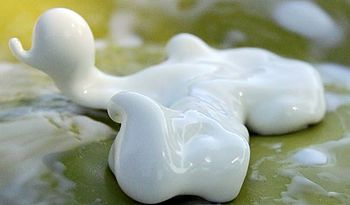Non-Newtonian Fluids: Difference between revisions
No edit summary |
No edit summary |
||
| Line 3: | Line 3: | ||
A non-Newtonian fluid is a specific type of fluid which does not behave in the same manner as regular fluids. The most notable difference in non-Newtonian fluids is that their viscosity is dependent on the shear rate, or the rate that shearing deformation is applied. In a Newtonian fluid, the relationship between the shear rate and force applied can be modeled by a linear curve. Non-Newtonian fluids exhibit a behavior which lacks a straight-line relationship between the shear rate and force applied, meaning that the viscosity of the fluid changes when a force is applied. | A non-Newtonian fluid is a specific type of fluid which does not behave in the same manner as regular fluids. The most notable difference in non-Newtonian fluids is that their viscosity is dependent on the shear rate, or the rate that shearing deformation is applied. In a Newtonian fluid, the relationship between the shear rate and force applied can be modeled by a linear curve. Non-Newtonian fluids exhibit a behavior which lacks a straight-line relationship between the shear rate and force applied, meaning that the viscosity of the fluid changes when a force is applied. | ||
[[File:thing.jpg| | [[File:thing.jpg|350px|thumb|right|This is oobleck, a 50/50 mixture of corn starch and water, while a vibrating force is acting on it.]] | ||
==Significance== | ==Significance== | ||
| Line 12: | Line 12: | ||
The basic behavior of a non-Newtonian fluid can be described with the following equation: | The basic behavior of a non-Newtonian fluid can be described with the following equation: | ||
[[File:Kyleequation.png]] | [[File:Kyleequation.png]] | ||
Revision as of 20:30, 3 December 2015
Claimed by Kyle Sabell
A non-Newtonian fluid is a specific type of fluid which does not behave in the same manner as regular fluids. The most notable difference in non-Newtonian fluids is that their viscosity is dependent on the shear rate, or the rate that shearing deformation is applied. In a Newtonian fluid, the relationship between the shear rate and force applied can be modeled by a linear curve. Non-Newtonian fluids exhibit a behavior which lacks a straight-line relationship between the shear rate and force applied, meaning that the viscosity of the fluid changes when a force is applied.

Significance
Applications
Non-Newtonian fluids have a variety of real-world applications. It has been found that they provide an excellent remedy to potholes, since the stress provided by fast-moving cars would drastically increase the viscosity of the dried fluid, providing a stable driving surface. These fluids also have a place in body armor, specifically bullet-proof vests. In industry, non-Newtonian fluids are often used in hydraulic systems because of they become thicker when a larger force is applied.
A Mathematical Model
The basic behavior of a non-Newtonian fluid can be described with the following equation:
Connectedness
- How is this topic connected to something that you are interested in?
- How is it connected to your major?
- Is there an interesting industrial application?
Examples of Non-Newtonian Fluids
- Ketchup
- Toothpaste
- Starch mixed with water
- Shampoo
- Blood
- Custard
- Paint
See also
Further reading
Books, Articles or other print media on this topic
External links
References
This section contains the the references you used while writing this page
